|
The
hunting field
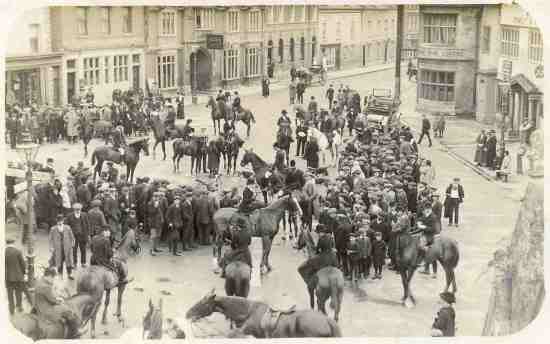
The Cottesmore Hunt meet in the Market Place
at Bourne
in the spring of 1914
Fox-hunting has become a controversial and
emotive subject in recent years, resulting in the Hunting Act of
2005 that banned the pursuit of wild animals with dogs.
Yet the traditional meets continue, particularly on Boxing Day,
and although the hounds are no longer allowed to hunt down foxes,
many hunts use techniques such as drag hunting with dogs setting
off on the trail of a scent laid about 20 minutes in advance by a
runner or rider dragging a lure.
The first Boxing Day meets after the introduction of the ban took
place last week, on Monday 27th December 2005, and some 250 of
them were held in England and Wales although the League Against
Cruel Sports and other anti-hunting organisations sent
representatives to many of them to ensure that they stayed within
the law.
Although it has been a less popular venue, Bourne was often the
centre of fox-hunting activity in South Lincolnshire in past
times, the Cottesmore Hunt, established 1666 by Viscount Lowther,
being one of the most active, together with the pack owned by Sir
John Trollope [who became the first Lord Kesteven when he was
raised to the peerage in 1869] and there were still regular meets
in recent years but apart from occasional forays by hunt
saboteurs, the sport attracted little adverse comment in this
area.
It was a different story in years past when hunts in the
neighbourhood pursued their activities with scant regard for
person and property because this was the sport of the landed
gentry who were also usually magistrates and few dared question
their activities. There were also scenes of real cruelty to
animals but they must be judged by the customs of the time and it
was to be another 150 years before the sport was finally banned as
barbaric although that is by no means the universal opinion.
One such incident involved Sir John Trollope’s hounds that met at
Manthorpe on Saturday 22nd January 1859 and soon picked up a fox,
chasing it into Bourne along South Road. A local newspaper
reported the rest of the incident:
At a little before one
o'clock reynard made his entrance into Bourne by the south side of
the town, passing through Mr Thomas Osborn's yard, through the paddock
owned by Mr George Nicholls, over the river and into the Rev
Joseph Dodsworth's bottom garden [the vicarage], thence he crossed
the Abbey Lawn and into Mr Dodsworth's top garden which is
surrounded by a wall more than six feet high. Here the poor fox
had, as it were, jumped into a large cage from which there seemed
no escape, and he quickly concealed himself behind some flower
pots in a little outhouse communicating with the garden.
This however, brought him only a short respite, as the hounds and
huntsmen were upon him and he was speedily doomed to death. He was
then brought on to the lawn and after the brush and head had been
cut off, the master of the hounds stepped forward and threw the
body of the fox into the air to fall amongst the dogs, which in a
very few moments, tore it to pieces and consumed it. Besides the
huntsmen, there were present on the lawn a large concourse of
persons who appeared highly excited by the sport.
Ten years later, Sir John Trollope's hounds were
again at the centre of an incident. The hunt met at Manthorpe,
near Bourne, on Saturday 12th March 1868 and after running a vixen
to ground in Dole Wood, they proceeded to Thurlby Wood where they
started another fox. A local newspaper takes up the story:
After about three hours'
chase to and from Thurlby and Northorpe, and again into the wood,
reynard, shortly before 4 o'clock, approached Bourne town by the
west side of the railway station and thence across the river
forming the back way of Mr Robert Munton's mill [now Baldock's Mill],
over the trenches, along the paddocks belonging to Mr John Gibson
and Mr Thomas Presgrave, and after making an unsuccessful effort
to mount the wall into the back premises of Messrs [Robert] Mills
and Company's soda water manufactory [in West Street], he finally
took refuge in Mr Thomas Heaton's hen roost, the occupants of
which made a precipitate retreat but in doing so, protested loudly
against reynard's unceremonious visit and doubtless he must have
felt ill at ease at their noisy cackling when he meant no harm for
it at once discovered his hiding place.
A couple of dogs were put in to keep him company and the result of
their short acquaintance we need not relate. He was then taken
into the Market Place and his brush, head and feet cut off and his
carcass thrown into the air to fall amongst the dogs which in a
few moments tore it to pieces and devoured it. Besides the
huntsmen, there were present a large number of persons who
appeared highly to relish the sport. One gentleman, in his anxiety
to be up at the death, was proceeding along the top of some low
buildings in Mr Heaton's yard when a portion of the pigsty roof
gave way and he fell through up to his chin, causing him some
injury and damage to the roof.
Because hunting invariably involved the gentry, there was great
public amusement whenever they suffered indignities such as that
which occurred on Saturday 25th January 1850, when riders with the
Cottesmore came to grief while in full pursuit on the outskirts of
Bourne. The hounds met at Castle Bytham and having raised a fox on
the Grimsthorpe estate, chased it across the countryside around
Edenham where it crossed the river, badly swollen by thawing snow,
but when they attempted to follow, several riders were swept off
their horses and left floundering in the water, their hats
floating ignominiously downstream as they struggled to reach the
safety of the bank, a tale that was recounted in some detail and
with much hilarity in the hostelries around Bourne for several
weeks.
|
MEETING WITH THE HUNT |
|
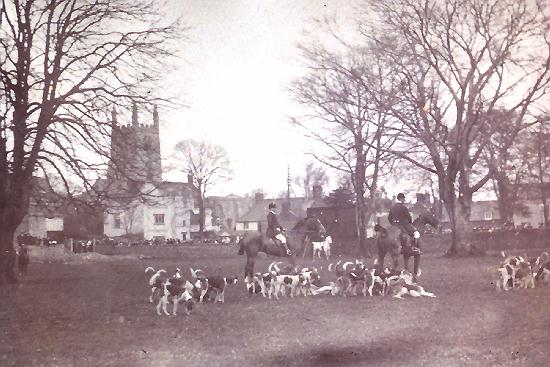 |
|
The Cottesmore Hunt meeting in the field
alongside the Red Hall, Bourne, circa 1935, and a picture postcard of the event
(below). |
|
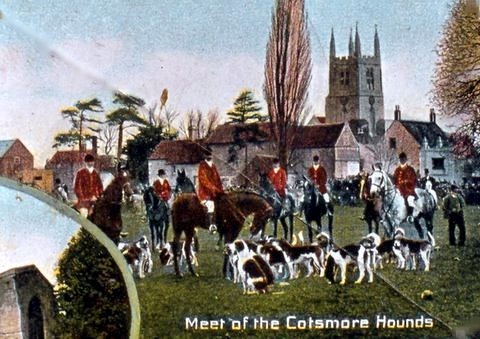 |
|
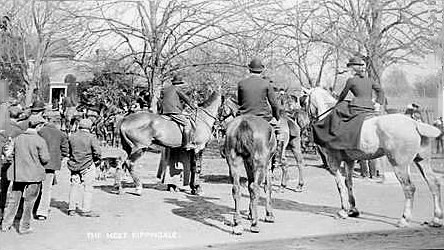 |
|
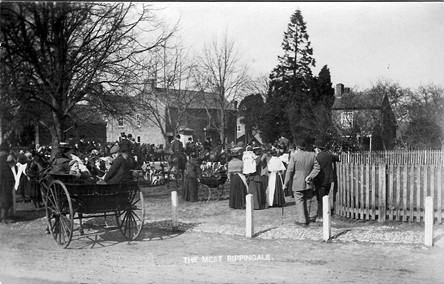 |
|
Two pictures of the Blankney Hunt meeting at Rippingale in 1905. |
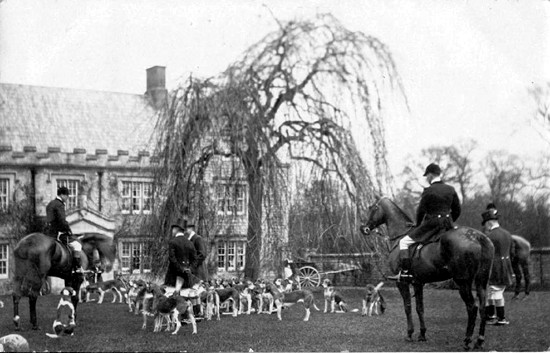 |
|
The Cottesmore Hunt pictured meeting at Irnham Hall in 1913. |
The appearance of the Cottesmore hounds in full cry
on the outskirts of Bourne on Friday 26th January 1872 also caused
a good deal of pleasure to local folk. Riders were unseated while trying to
cross low lying land that had been flooded by recent rain and one
found himself up to the neck in a dyke with a struggling horse
which was rescued with difficulty. The fox they were chasing made
its way across a row of cottage gardens and the owners rushed to the upstairs windows to watch the cause of the hubbub, finding their little plots invaded by swift
running hounds and eager huntsmen. The fox, however, which had
given the field a gallop of an hour and a half, eventually escaped
unharmed.
But there were also tragedies in the hunting field and in 1861 a
local doctor met his death while riding to hounds. Mr Henry
Bromley, of Rippingale, near Bourne, who was also surgeon to the
Bourne Rifle Corps, joined the Duke of Rutland's hounds when they
met at Lenton village on Friday 20th December but shortly
afterwards, near Kirkby Underwood, his horse slipped at a
dangerous fence and he was pitched over the top, the horse
following, trampling on his body and inflicting fearful injuries
internally and externally. He was taken home by carriage and
medical aid summoned from Bourne and Stamford but after enduring
great agony for many hours, he died the following Monday.
Hunting has had a declining reputation in recent years and hunts
have recognised their unpopularity by keeping contentious issues
to a minimum. There was however one incident in 1998 which raised
public anger when the Cottesmore chased a fox through Bourne Wood,
much to the distress of walkers who had to jump aside as horses
galloped along footpaths in pursuit, and finally ended up at the
Beech Avenue entrance where the fox took refuge in a culvert and
the hounds ran amok in a private garden. The hunt subsequently
tendered a public apology and there were no further incidents.
In view of the barbarity apparent at those earlier incidents
described, accounts of which survive in some detail, it is
difficult to understand how fox-hunting continued for so long yet
the sight of horses and hounds at the traditional meets with a
picturesque village as a back drop, such as Folkingham where the Belvoir Hunt met in centuries past, will remain an evocation of old
England for many years to come.
WRITTEN DECEMBER 2005
|

A watercolour drawing of the scene by Cuthbert
Bradley, circa 1929 |
|
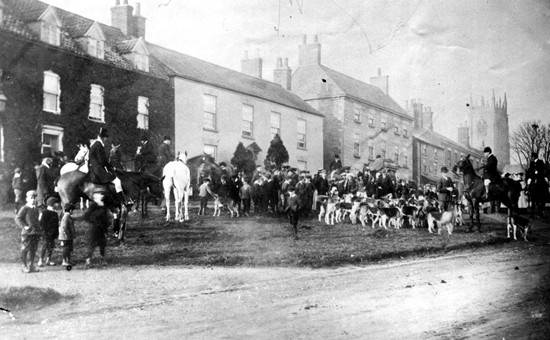
The Belvoir Hunt meeting at Folkingham circa 1910 |
|
THE VILLAGE of Folkingham
has in centuries past been the venue for periodic meets of the hunt,
particularly the Belvoir, the spacious market square outside the
Greyhound Hotel being a most attractive setting, and this
association was recalled by a writer in one of the country's leading
hunting magazines during the early years of the 20th century:
A welcome always awaits the
Belvoir Hunt from the sporting gathering of onlookers who flock in
from the villages round, many of them with riding records in the
past, for the lay of the ground ensures everyone an impressive view.
Situated in a fine undulated country of large-acred grass and
ploughed fields, stoutly fenced and ditched, there is the choice of
good hunting ground whichever way the hounds turn, and coverts wide
apart ensure that a fox must seek safety in flight. It is a district
where many a promising young hunter has been discovered in the
making, for the local field comes out to ride.
Many a stirring hunt is associated with a Folkingham meet,
especially during the sixteen seasons of Sir Gilbert and Lady
Greenall’s Mastership – the present Lord and Lady Daresbury – the
wonderful sight of matched horses and hounds in the square appealing
to the sporting instincts of Lincolnshire, noted for the rearing of
the finest stock. Then followed the Mastership of Major “Tommy”
Bouch, who hunted hounds himself, and brought off some remarkable
long hunts from Folkingham coverts down in the fen country, killing
his foxes at the finish, and the same evening writing graceful
hunting sonnets. Major Bouch’s reign is also memorable for the
visits of royalty, the Prince of Wales and the Duke of York on
different occasions, accompanying him from Woolsthorpe, where they
stayed as his guests overnight to hunt in the Folkingham district
next day.
Probably the highest priced hunter ever seen in the Market Square
was Woodpigeon, a big brown horse with a wonderful shoulder and
extraordinary character, ridden by the Duke of York, for which Major
Bouch had given 1,050 guineas, when Colonel R Clayton Swan sold his
stud at Leicester. During the following Mastership of Captain
Marshall Roberts, when all the royalties rode with the Belvoir,
there was much disorganisation owing to cattle plague restrictions
and Lincolnshire, with its clean bill of health, attracted the
talent of Melton Mowbray, twenty-five miles distant. For the time
being Folkingham became a fashionable hunting centre!
After considerable law had been allowed for the fog to lift on
Friday last, Mr Tonge moved away with hounds to draw Heathcote’s
Covert, a mile or so distant. Approached on the west side in the
valley, the strip of firs is known as Eva’s Belt, planted thirty
years ago by Mr Tom Heathcote and named after his wife. Mention of
the late squire calls to mind the days of the Belvoir Hunt
steeplechases over the course between Lenton and Ingoldsby which he
managed with such success. Heathcote’s Covert, favoured ground for
foxes and pheasants, was planted some sixty years ago by Rev Thomas
Heathcote, vicar of Lenton by Ingoldsby, who inherited the
Folkingham property, together with the Durdans by Epsom, from a
relative, Mr Arthur Heathcote, one time Master of the Surrey
Staghunds. The Durdans was sold at once to the late Lord Rosebery
and Folkingham followed the same fate, after the war, like many
another family inheritance. The old squires have gone, to be
replaced by smallholders with big hearts, sportsmen to the core.
Heathcote Covert today, with the land around, is owned by Mr Robert
Watts whose charming home, Thorpe Latimer by Melpringham, is a meet
of hounds, and Mrs Watts, who has hunted all her life with the
Belvoir, now pilots a youthful family in the way they should go.
Writing as a resident smallholder with a wife who inherits Heathcote
acres, I realise it is time to take the curb-chain up four links,
for the subject of Folkingham, like my old grey horse, is apt to get
clean away into the land of delightful memories.
– Whipster, writing in the Horse and Hound, 22nd November
1929.
(Note: Whipster was the
pseudonym of Cuthbert Bradley) |
See also Newspaper reports
of the time
More watercolours by Cuthbert Bradley

Go to:
Main Index Villages
Index
|







